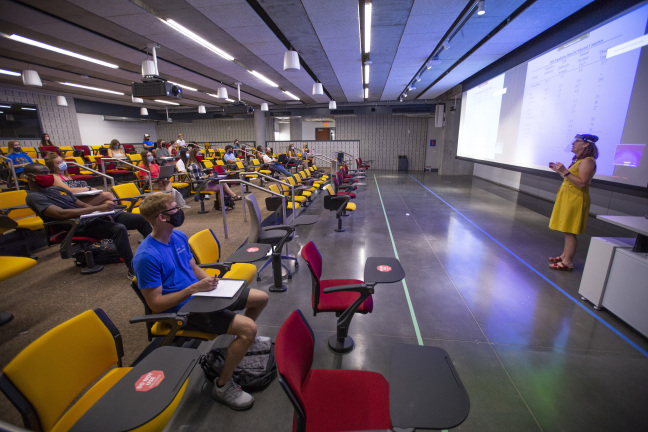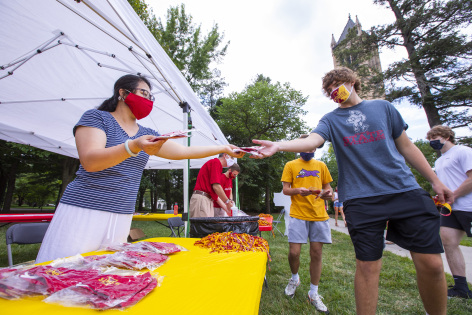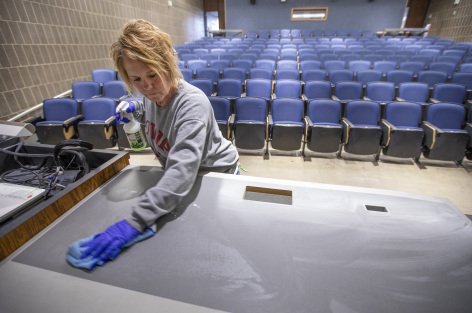
Space in the new Student Innovation Center was converted into a classroom for the fall semester. The return to campus was a major milestone in the university's pandemic response. Photo by Christopher Gannon
By Angie Hunt, News Service
AMES, Iowa – Day 365 and counting. It’s been a year since Iowa State University initiated its Emergency Operation Center (EOC) to provide a coordinated, institution-wide response to the COVID-19 pandemic.
So much has happened since Jan. 27, 2020 – Day 1 – when university leaders received an initial briefing from the incident management team, that it is challenging to adequately capture it all. While counting days is one way to measure the ongoing effort to maintain Iowa State’s research and teaching mission during the pandemic, it can also be measured by:
- The support for nearly 400 students who had to return from studying abroad in the spring.
- The more than 6,000 classes that were moved online in just two weeks when the university transitioned to virtual learning in March.
- The 24,734 COVID-19 test samples collected by the public health team during the fall semester and processed by the Veterinary Diagnostic Lab as part of ISU’s targeted testing strategy.
- And there’s the 655,000+ Webex and Zoom meetings over the past year to keep the university connected.
But perhaps the most impactful measurement – while not as easy to quantify – are the countless times people volunteered their time to help with move-in testing or hand out face coverings; stepped up to take on new roles to lead public health and university response efforts; and continued to get the job done despite the fears and uncertainty of a global pandemic.
“It's about the people and will always be about the people at Iowa State,” President Wendy Wintersteen said. “So many people came together and performed at an extraordinary level, and they did so for their love of the university, their care for each other and the collaborative culture we have at Iowa State.”
Responding to changing needs

Volunteers hand out face coverings to students returning to campus in the fall. Photo by Christopher Gannon
For example, when the public health team needed help in the fall with case management, contact tracing and registration for COVID-19 testing, dozens of finance and human resource specialists responded to address the need. Eric Mulder, a procurement and expense specialist, filled a variety of roles, depending on daily needs at the testing center. He says the impact of his work really started to sink in near the end of fall semester.
“Several students were getting tested before heading home, and knowing our team helped make that possible was a very rewarding feeling,” Mulder said. “And getting to see the testing process firsthand has given me the utmost respect for health care workers everywhere.”
University Human Resources Vice President Kristi Darr says the pandemic created new challenges and needs that often required a quick and creative response. The UHR team assisted employees as they transitioned to working remotely in the spring, while supporting those who continued to meet critical needs on campus; collaborated with community partners to find child care solutions when schools closed; and provided accommodations and adequate time off for those needing to isolate or quarantine to limit the spread of infection.
“It’s phenomenal,” Darr said. “If you think about the sustained effort to implement improved service delivery, Workday, becoming one team, then responding to COVID and implementing class comp review. It’s certainly one for the books.”
On the front lines

Custodian Carol Ann Musser disinfects the teaching table in a Carver Hall auditorium as part of deep cleaning efforts during spring break week. Photo by Christopher Gannon
Facilities planning and management (FPM) staff have been on the front lines of the pandemic response from the beginning, providing enhanced cleaning across campus, preparing nearly 150 classrooms over the summer to meet capacity limitations and installing an estimated 250 hand sanitizer units across campus. Associate Vice President of Facilities Planning and Management Paul Fuligni says the FPM team also installed thousands of signs across campus, addressed ventilation issues and recovered from a derecho a week before the start of fall classes.
“Preparing the campus to safely bring together almost 40,000 people was a huge challenge, and people throughout FPM responded in many ways,” Fuligni said. “It was a tremendous team effort that directly contributed to the completion of the fall semester on campus.”
Since Day 1, ISU Emergency Manager Clayton Oliver and the EOC team have documented major decisions and milestones, big and small, along with noting each day – from one to 365 and counting – of the university’s response. Below is a snapshot of some of those milestones from the past year.
Timeline of COVID-19 response on campus
January 2020
- Emergency operation center activated to coordinate campus response.
- Travel to China suspended for students and employees.
- Students return from study abroad programs in China.
February 2020
- Travel to South Korea and Italy suspended for students and employees.
- Students return from study abroad programs in South Korea and Italy.
March 2020
- Board of Regents suspends international travel and recalls students, scholars abroad.
- First COVID-19 case reported in Iowa.
- Classes move online for remainder of spring semester.
- University remains open, but reduces campus operations.
- All university events and activities canceled, postponed or virtual.
April 2020
- Food pantry opens in Union Drive Community Center on campus.
- Board of Regents announce students will return to campus in the fall.
- President Wintersteen names Executive Committee for Fall Planning.
May 2020
- Spring commencement ceremonies held virtually.
- Iowa State receives $21.7 million in CARES funding with half used for emergency student financial aid grants and the other half for institutional operations.
- First COVID-19 case reported on campus.
June 2020
- Phased return to campus begins.
- ISU announces condensed fall semester with mix of online, hybrid and in-person classes.
July 2020
- Face coverings required on campus.
- Thielen Student Health Center offers COVID-19 testing for students, faculty and staff.
- Response teams created to address needs and issues for fall semester.
August 2020
- Move-in testing conducted at Lied Recreation Center for students moving into residence halls and campus apartments.
- Derecho causes extensive power outages on campus.
- COVID-19 policy on student social gatherings implemented.
September 2020
- Testing center opens at Johnny’s inside Hilton Coliseum.
- Launch of COVID-19 Public Health Data website to report testing, isolation and quarantine data.
- Decision to adjust spring semester calendar and cancel spring break; winter session announced.
October 2020
- University conducts random, asymptomatic COVID-19 testing.
November 2020
- Free COVID-19 testing offered to students prior to leaving for winter break.
- Fall semester ends day before Thanksgiving; virtual fall commencement.
December 2020
- Nearly 2,300 students enroll in first-ever winter session.
- ISU receives first vaccine allocation for health services staff.